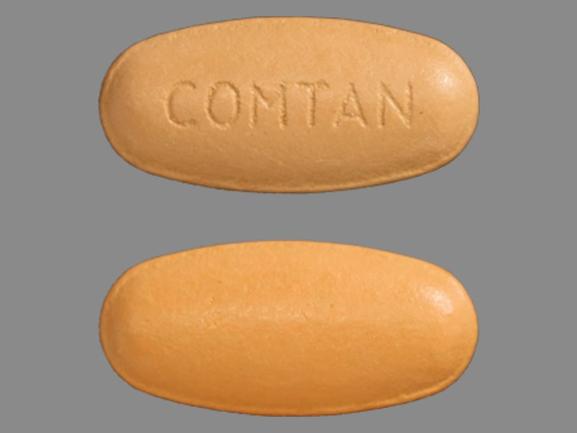Comtan Side Effects
Generic name: entacapone
Medically reviewed by Drugs.com. Last updated on May 15, 2023.
Note: This document contains side effect information about entacapone. Some dosage forms listed on this page may not apply to the brand name Comtan.
Applies to entacapone: oral tablet.
Serious side effects of Comtan
Along with its needed effects, entacapone (the active ingredient contained in Comtan) may cause some unwanted effects. Although not all of these side effects may occur, if they do occur they may need medical attention.
Check with your doctor immediately if any of the following side effects occur while taking entacapone:
More common
- Absence of or decrease in body movements
- hyperactivity
- increase in body movements
- seeing, hearing, or feeling things that are not there
- twisting
- twitching
- uncontrolled repetitive movements of the tongue, lips, face, arms, or legs
Less common
- Cough or hoarseness
- fever or chills
- lower back or side pain
- painful or difficult urination
Rare
- Confusion
- muscle cramps
- pain
- shortness of breath
- stiffness
- unusual tiredness or weakness
Other side effects of Comtan
Some side effects of entacapone may occur that usually do not need medical attention. These side effects may go away during treatment as your body adjusts to the medicine. Also, your health care professional may be able to tell you about ways to prevent or reduce some of these side effects.
Check with your health care professional if any of the following side effects continue or are bothersome or if you have any questions about them:
More common
- Abdominal or stomach pain
- constipation
- diarrhea
- dizziness
- nausea
Less common
- Acid or sour stomach
- anxiety
- belching
- bruising
- burning feeling in the chest or stomach
- difficult or labored breathing
- dry mouth
- heartburn
- indigestion
- irritability
- loss of strength or energy
- muscle pain or weakness
- passing gas
- restlessness
- sleepiness or unusual drowsiness
- small, red spots on the skin
- stomach discomfort, upset, or tenderness
- sweating increased
- tightness in the chest
- tremor
- trouble sleeping
- unusual or unpleasant (after) taste
- unusual weak feeling
For Healthcare Professionals
Applies to entacapone: oral tablet.
Nervous system
There were no cases of neuroleptic malignant syndrome during clinical trials. Since market introduction, there have been isolated cases, especially following abrupt reduction or discontinuation of this drug and other concomitant dopaminergic drugs.[Ref]
Very common (10% or more): Dyskinesia (up to 27%), hyperkinesia (10%)
Common (1% to 10%): Hypokinesia, dizziness, somnolence, taste perversion, aggravated parkinsonism, dystonia, headache, tremor
Frequency not reported: Falling asleep during activities of daily living
Postmarketing reports: Neuroleptic malignant syndrome[Ref]
Gastrointestinal
Very common (10% or more): Nausea (up to 14%), diarrhea (up to 11%)
Common (1% to 10%): Abdominal pain, constipation, vomiting, dry mouth, dyspepsia, flatulence, gastritis, gastrointestinal disorders
Very rare (less than 0.01%): Anorexia
Postmarketing reports: Colitis[Ref]
In clinical trials, diarrhea occurred in approximately 10% of patients. It was generally mild to moderate, but in 1.3% of people it was severe. Upon discontinuation, diarrhea generally resolved. There have been postmarketing reports of drug-induced microscopic colitis, primarily lymphocytic colitis.[Ref]
Genitourinary
Very common (10% or more): Urine discoloration (10%)[Ref]
General
The most commonly reported adverse reactions included dyskinesia, urine discoloration, diarrhea, nausea, hyperkinesia, abdominal pain, vomiting, and dry mouth.[Ref]
Respiratory
Common (1% to 10%): Dyspnea
Frequency not reported: Pulmonary fibrosis[Ref]
Dermatologic
Common (1% to 10%): Increased sweating
Rare (less than 0.1%): Erythematous, maculopapular rash
Very rare (less than 0.01%): Urticaria
Frequency not reported: Skin hair, beard, and nail discolorations[Ref]
Musculoskeletal
Isolated cases of rhabdomyolysis have occurred in patients treated with this drug. The complicated nature of these cases makes it difficult to determine the role this drug may have had. Rhabdomyolysis has been reported secondary to severe dyskinesias or neuroleptic malignant syndrome (NMS) in patients with Parkinson's disease.[Ref]
Common (1% to 10%): Back pain, falls, leg cramps
Postmarketing reports: Rhabdomyolysis[Ref]
Psychiatric
Common (1% to 10%): Anxiety, insomnia, hallucinations, confusion, paranoia
Uncommon (0.1% to 1%): Agitation
Frequency not reported: Impulse control disorders including pathological gambling, increased libido, hypersexuality, compulsive spending or buying, binge eating and compulsive eating[Ref]
Hematologic
Common (1% to 10%): Purpura, decreased hemoglobin[Ref]
A clinically significant decrease in hemoglobin has been observed in 1.8% of patients. The underlying mechanism may involve decreased absorption of iron from the gastrointestinal tract.[Ref]
Other
Common (1% to 10%): Fatigue, asthenia, pain, vertigo[Ref]
Cardiovascular
The incidence of myocardial infarction and other ischemic heart disease events was 0.43% and 1.54%, respectively, in an analysis of 13 double-blind studies involving 2082 patients.[Ref]
Common (1% to 10%): Ischemic heart disease events other than myocardial infarction (e.g., angina pectoris, postural hypotension
Uncommon (0.1% to 1%): Myocardial infarction[Ref]
Hepatic
Rare (less than 0.1%): Abnormal liver function tests
Postmarketing reports: Hepatitis with mainly cholestatic features[Ref]
Frequently asked questions
More about Comtan (entacapone)
- Check interactions
- Compare alternatives
- Pricing & coupons
- Reviews (7)
- Drug images
- Latest FDA alerts (2)
- Dosage information
- During pregnancy
- Generic availability
- Drug class: dopaminergic antiparkinsonism agents
- Breastfeeding
- En español
Patient resources
Professional resources
Related treatment guides
References
1. Product Information. Comtan (entacapone). Novartis Pharmaceuticals. 2001;PROD.
2. Cerner Multum, Inc. UK Summary of Product Characteristics.
3. Cerner Multum, Inc. Australian Product Information.
Further information
Always consult your healthcare provider to ensure the information displayed on this page applies to your personal circumstances.
Some side effects may not be reported. You may report them to the FDA.

